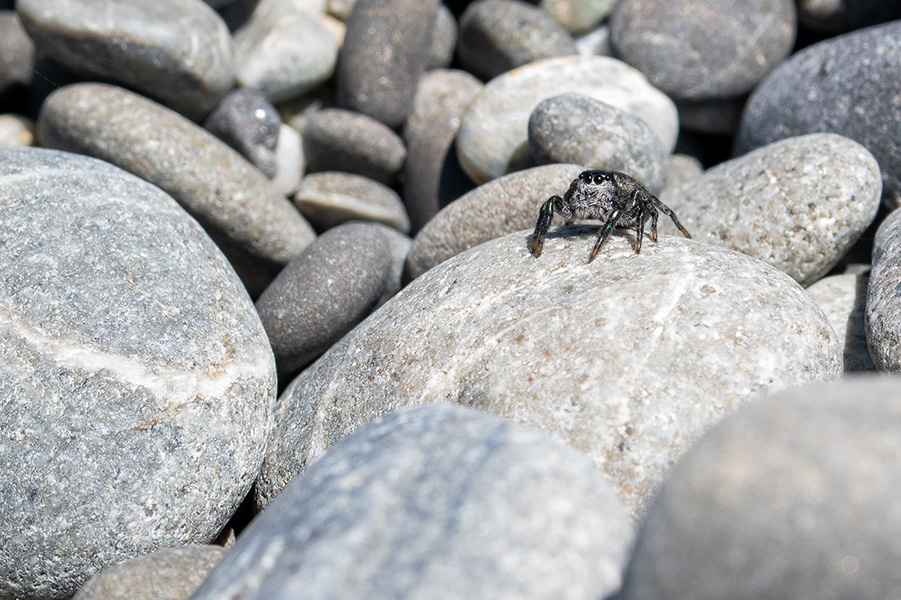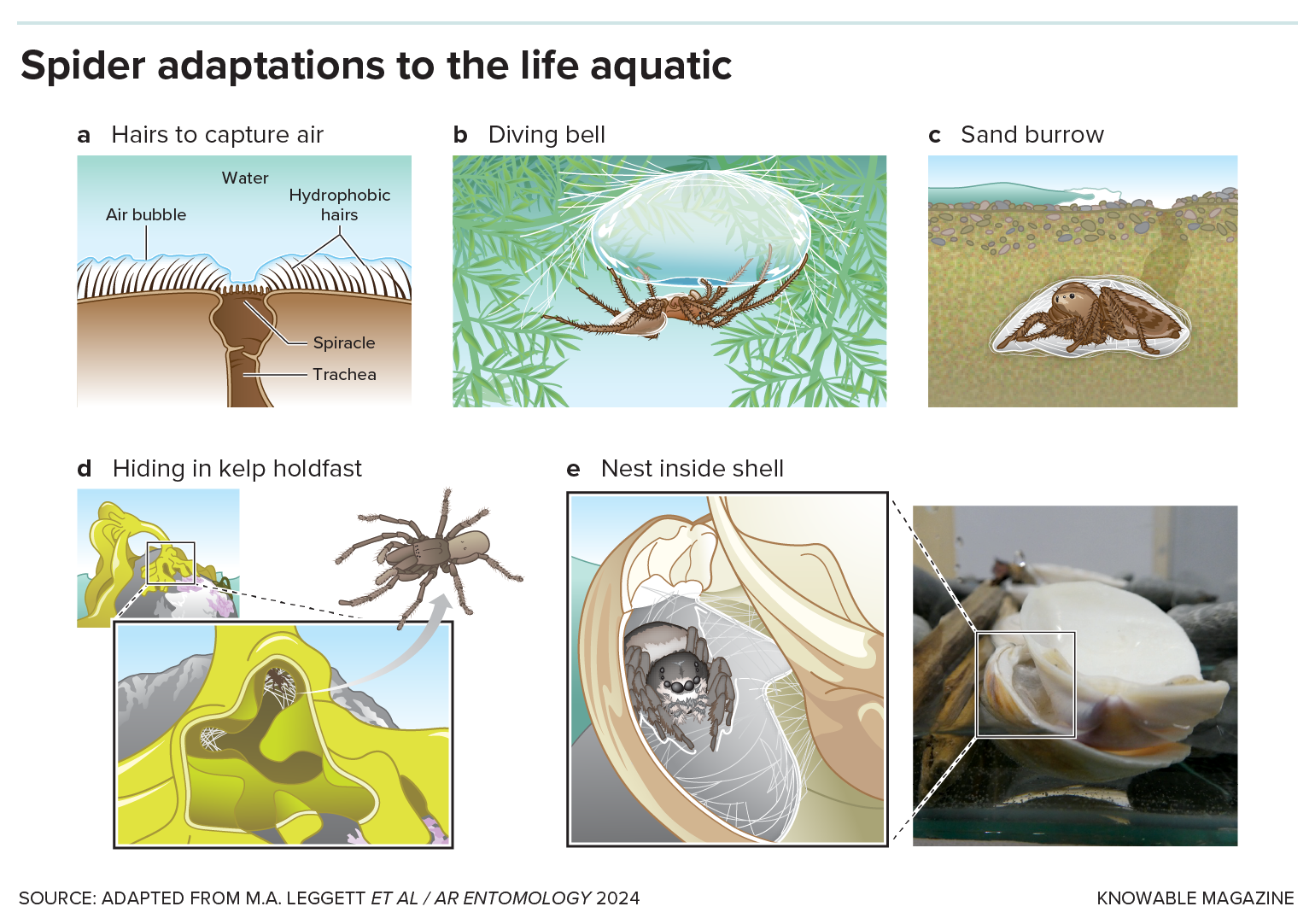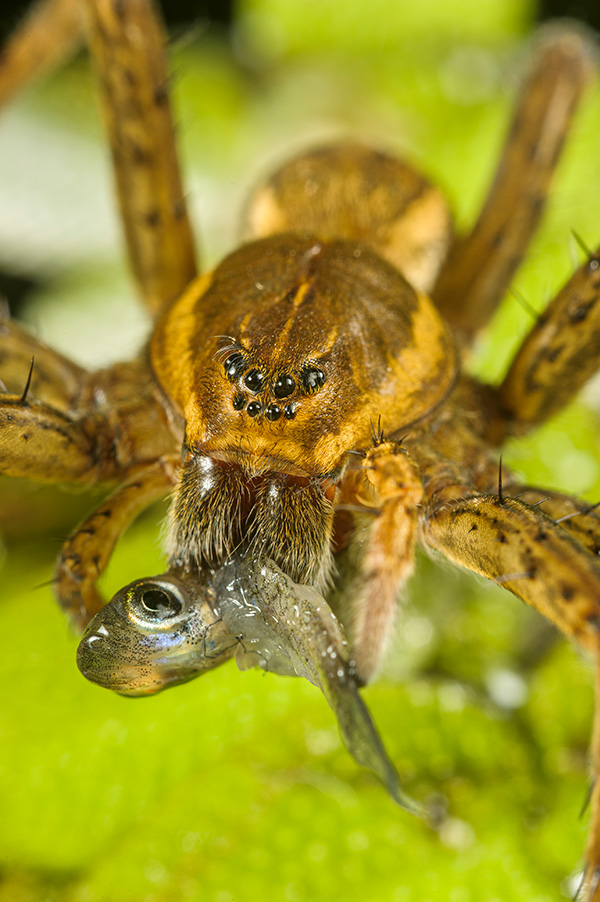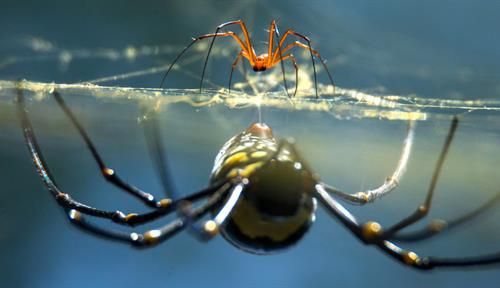They swim and they spin: Meet the aquatic spiders
Some make nests inside seashells, others tote bubbles of air on their backs. The spiders that went back to water evolved lots of slick survival strategies.
Support sound science and smart stories
Help us make scientific knowledge accessible to all
Donate today
Shrubbery, toolsheds, basements — these are places one might expect to find spiders. But what about the beach? Or in a stream? Some spiders make their homes near or, more rarely, in water: tucking into the base of kelp stalks, spinning watertight cocoons in ponds or lakes, hiding under pebbles at the seaside or creek bank.
“Spiders are surprisingly adaptable, which is one of the reasons they can inhabit this environment,” says Ximena Nelson, a behavioral biologist at the University of Canterbury in Christchurch, New Zealand.
Finding aquatic or semiaquatic spiders is difficult work, Nelson says: She and a student have spent four years chasing a jumping spider known as Marpissa marina around the pebbly seaside beaches it likes, but too often, as soon as they manage to find one it disappears again under rocks. And sadly, some aquatic spiders may disappear altogether before they come to scientists’ attention, as their watery habitats shrivel due to climate change and other human activities.

The jumping spider Marpissa marina of New Zealand’s pebbly beaches is difficult for researchers to find.
CREDIT: XIMENA NELSON
What scientists do know is that dozens of described spider species spend at least some of their time in or near the water, and more are almost surely awaiting discovery, says Sarah Crews, an arachnologist at the California Academy of Sciences in San Francisco. It also appears that spiders evolved aquatic preferences on several distinct occasions during the history of this arthropod order. Crews and colleagues surveyed spiders and reported in 2019 that 21 taxonomic families include semiaquatic species, suggesting that the evolutionary event occurred multiple independent times. Only a swashbuckling few — not even 0.3 percent of described spider species — are seashore spiders; many more have been found near fresh water, says Nelson.
It’s not clear what would induce successful land-dwelling critters to move to watery habitats. Spiders, as a group, probably evolved about 400 million years ago from chunkier creatures that had recently left the water. These arthropods lacked the skinny waist sported by modern spiders. Presumably, the spiders that later returned to a life aquatic were strongly drawn by something to eat there, or driven by unsafe conditions on land, says Geerat Vermeij, a paleobiologist and professor emeritus at the University of California, Davis — because water would have presented major survival challenges.
“Since they depend on air so much, they are severely limited in whether they can do anything at all when they are submerged, other than just toughing it out,” says Vermeij. Newly aquatic spiders would have had to compete with predators better adapted to watery conditions, such as crustaceans, with competition particularly fierce in the oceans, Vermeij says. And if water floods a spider’s air circulation system, it will die, so adaptations were obviously needed.
But spiders as a group already possess several water-friendly features, suggests Crews. They have waxy, water-repellent exteriors, often covered in hairs that conveniently trap air bubbles. Even having eight legs is helpful, says Nelson: Spiders can distribute their weight nicely while they skitter across a water surface, or use their octet of appendages to row along.
Some spiders take their aquatic adaptations to the next level, though. Consider the diving bell spider, Argyroneta aquatica, an overachieving arachnid that is the only one known to do it all under water: breathe, hunt, dine on insects and their larvae, and make spiderlings. Found in fresh water in Europe and parts of Asia, it spins a silken underwater canopy and brings air bubbles from the surface to its submerged home via its body hairs. When it goes out, it carries a smaller air bubble, like a little scuba tank, on its back.
Seashore spiders face particularly daunting conditions, says Nelson, who coauthored an article about adaptations of marine spiders for the 2024 Annual Review of Entomology. “There’s a splash zone,” she says. “It’s kind of a wild environment.” A spider might be baking in hot sun one minute, drenched in chilly saltwater the next. Some spiders migrate up and down their beaches with the tides; Nelson speculates that they might monitor lunar cycles to anticipate when to move.
Other seashore spiders spin watertight nests where they hide out for hours while the tide is in. M. marina, for example, seeks seashells with nice, concave spaces in which to spin safe tents. Another spider, Desis marina, hides in holdfasts where bull kelp attaches to rocks, lining the holdfast’s interior with silk to create an air-filled pocket and staying submerged for as long as 19 days. D. marina emerges only when the tide is going out, to hunt for invertebrates like shrimp.

Spiders already possess some adaptations that help in the water, such as hairs that repel water and trap air around them (a). The diving bell spider Argyroneta aquatica uses these hairs to transport a large volume of air to its underwater canopy (b). Other spiders burrow under the sand and surround their nests with waterproof silken barriers to stay safe when the tide is high (c). Desis marina builds its own watertight silk nest in the holdfast where bull kelp attaches to rocks (d). Other spiders, such as Marpissa marina, build their waterproof nests inside old seashells (e).
A spider that’s even occasionally submerged in saltwater or eating briny seafood will also have to maintain proper internal salt levels. “Presumably, they will be able to concentrate the salt somehow and then poo it out,” Nelson says. Scientists don’t know how marine spiders pull this off. And at least one intertidal-zone spider, Desis formidabilis of South Africa’s cape, comfortably maintains an interior salt concentration much like the crustaceans it eats, according to a 1984 study. (Freshwater species also probably require adaptations because their insides must stay saltier than their surroundings or food, Vermeij speculates.)
When a spider hides out with a limited air supply for days or weeks at a time, oxygen levels also may become a critical issue. Intriguingly, researchers have identified gene variants within the oxygen-guzzling, energy-making mitochondria of aquatic spiders that may help them cope with low-oxygen environments. These changes mirror beneficial changes to mitochondrial genes in birds that live in high-altitude, low-oxygen environments.
In another study, researchers investigated the genes used in the silk glands of aquatic and land spiders. They found that water-spider silk seems to have a high proportion of the water-repelling amino acid pair glycine and valine — which might also be an adaptation, they suggest.

A fen raft spider (Dolomedes plantarius) gobbles up a young mosquitofish (Gambusia affinis) — a good deed, as this fish is an invasive species in Italy where the spider lives.
CREDIT: EMANUELE BIGGI / ANURA.IT
Creeping extinction
But all the adaptations in the world might not be enough to save some water spiders. Nelson’s M. marina, for example, seems to be very particular about the beaches it occupies. The pebbles must be just right, not too big or small. If sea level rise inundates M. marina’s beaches, it’s possible the spiders will have nowhere else to go, Nelson says. “So those spiders will be lost.”
Marco Isaia, an arachnologist at the University of Turin, Italy, investigated the wetland habitats of the diving bell spider and the fen raft spider, Dolomedes plantarius. As wetlands continue to disappear, the habitats available to each species will contract by more than 25 percent over a decade, and their ideal ranges will move northward, Isaia and colleagues predicted in a 2022 study. It would be difficult for the spiders to cross dry land for new wetlands, and north European winters might prove too cold anyway. “The loss and degradation of wetland habitats is expected to have serious impacts on their survival,” says Isaia, “and an increase in their extinction risk.”
Given these risks, some aquatic spiders might go the way of the dodo before science gets a handle on them. “I suspect in every rocky bed of beach or river, there are probably spiders that we just don’t know exist there,” says Nelson. “Because they’re hiding.”
10.1146/knowable-042424-1
TAKE A DEEPER DIVE | Explore Related Scholarly Articles






